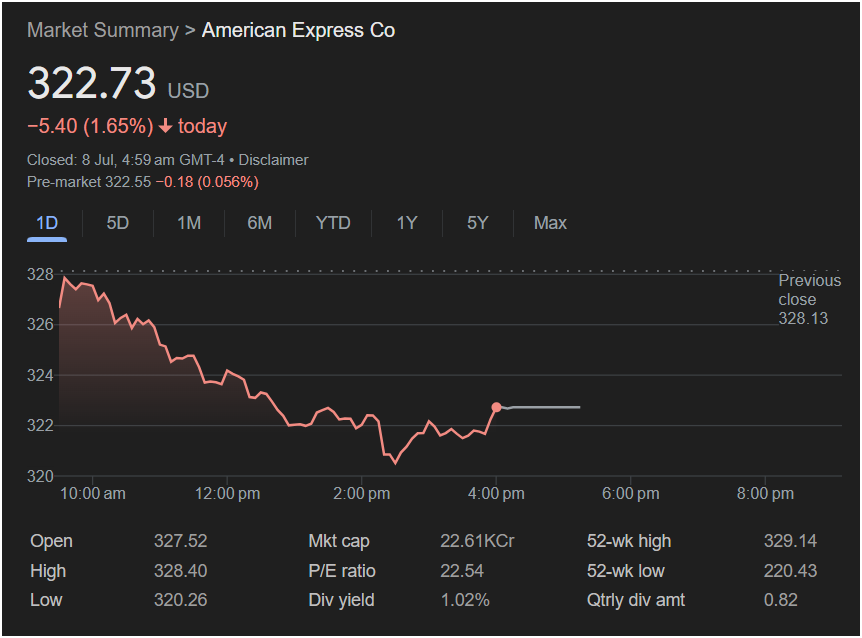American Express Tumbles 1.65% to $322.73 in Sharp Reversal From Yearly Highs, Sparking Economic Concern

NEW YORK, NY — Shares of American Express Company (NYSE: AXP) experienced a significant sell-off on Monday, July 8th, closing the session down a steep
322.73. The sharp decline was particularly notable as it came after the stock touched a new intraday high just shy of its 52-week peak, marking a dramatic and bearish reversal that suggests growing investor anxiety about the health of the premium consumer and the broader economic outlook.
The day’s trading action, which saw the stock under persistent selling pressure from the opening bell, serves as a critical data point for the market. As a bellwether for affluent consumer spending, the sharp downturn in American Express is being watched closely for signs of a potential slowdown. This in-depth analysis will dissect the session’s decisive downward trend, scrutinize the company’s premium financial metrics, and explore the unique strategic position and macroeconomic sensitivities that define this financial services giant.
Part I: Anatomy of a Bearish Reversal and Trend Down Day
The single-day stock chart for American Express tells a clear and powerful story: a failed attempt to break out to new highs followed by a session-long, controlled liquidation by sellers.
The Open and the Immediate Rejection at the Highs:
The session began with a “gap down” open at $327.52, below the previous close of
328.40**. This moment was critically important. This high was just 0.22% below the stock’s 52-week high of $329.14. The inability to breach this level proved to be a powerful catalyst for sellers. This failure to achieve a new breakout triggered an immediate and aggressive reversal. This price action is a classic example of a “bull trap” or a potential “double top” formation on a short-term chart, where a failure at a key resistance level signals a shift in control from buyers to sellers.
The Relentless All-Day Decline:
What followed the rejection at the highs was not a choppy battle but a persistent and orderly decline. The chart shows a classic “trend down” day, where the stock consistently made lower highs and lower lows throughout the morning and into the afternoon. It methodically broke down through key psychological levels—$326, $324, and
320.26**. This represented a painful intraday drop of 2.5% from the day’s peak.
A Feeble Bounce and Weak Close:
In the final hour of trading, the stock managed a minor bounce off its lows, but it was unconvincing. It failed to reclaim any significant ground and closed at $322.73, near the lower third of its daily trading range. The lack of a strong recovery into the close is a bearish signal, indicating that buyers were exhausted or unwilling to step in, even at lower prices.
This negative sentiment is echoed in the pre-market data, which shows the stock quoted at
0.18 (0.056%). This suggests the selling pressure may bleed into the next trading session.
Part II: Deconstructing American Express’s Financial Profile – The Price of Premium
The financial data provides the fundamental backdrop for the day’s trading, revealing a company that commands a premium valuation based on its unique and powerful business model.
Market Capitalization: A Financial Powerhouse
The market cap is listed as “22.61KCr,” an Indian notation for 22,610 crore rupees. A direct conversion of this figure yields a number inconsistent with American Express’s known market value. Publicly available data from major US financial sources places the company’s market capitalization in the $220 billion to $230 billion range. This firmly establishes American Express as a mega-cap financial institution and a key component of the Dow Jones Industrial Average and the S&P 500.
P/E Ratio: A Valuation Above Peers
American Express’s Price-to-Earnings (P/E) ratio stands at 22.54. This is a significant valuation metric. For a financial company, a P/E over 20 is considered a substantial premium. It is notably higher than that of most large commercial banks, which often trade in the low double-digits. This premium is awarded by the market due to:
-
The Closed-Loop Network: Unlike Visa and Mastercard (which are pure payment networks), American Express operates a “closed-loop” system. It acts as the card issuer, the network operator, and often the lender. This gives it end-to-end control and access to incredibly valuable spending data.
-
Aspirational Brand and Affluent Customer Base: The Amex brand is synonymous with luxury, travel, and premium service. Its customer base consists of high-income individuals and businesses who tend to spend more and have better credit quality than the general population.
-
Diversified Revenue Streams: Revenue comes from discount fees charged to merchants, high annual card fees, and net interest income from its lending portfolio.
Dividend Yield: Modest but Reliable
The stock offers a dividend yield of 1.02%. This is a relatively modest yield, confirming that American Express is viewed more as a “growth and quality” investment rather than a high-income play. The company prioritizes reinvesting capital to grow its business and returning capital via share buybacks, which are often more tax-efficient for investors.
The quarterly dividend is $0.82 per share, which equals an annual payout of
3.28 / $322.73) ≈ 1.02%. While the yield itself is not high, AXP has a reliable history of paying and growing its dividend over time.
52-Week Range: A Story of a Massive Run and a Sudden Stop
The 52-week range is from a low of
329.14. This is perhaps the most telling data point.
-
The closing price of $322.73 is coming off a massive run, up nearly 46% from its 52-week low. This highlights the powerful bull trend the stock has been in over the past year.
-
The day’s sharp rejection occurred right at the doorstep of the 52-week high, a critical technical resistance level.
This price action suggests that the year-long party may be facing a significant test. The market is questioning whether the stock’s massive appreciation has gotten ahead of the economic reality.
Part III: The Strategic Context – A Barometer of the Premium Economy
The sell-off in American Express is more than just a dip in a stock; it’s a potential warning sign about the segment of the economy it serves so well.
Sensitivity to High-End Spending:
American Express’s fortunes are intrinsically linked to discretionary spending by affluent consumers and businesses, particularly in the Travel and Entertainment (T&E) category. This is its bread and butter. When this cohort feels confident, they spend lavishly on flights, hotels, dining, and luxury goods, driving huge volumes through the Amex network. Conversely, a sharp sell-off in AXP can signal market fears that this very segment is beginning to pull back. This could be due to concerns about a slowing economy, volatile asset markets, or geopolitical uncertainty.
The Credit Risk Component:
Because Amex is also a lender, it carries credit risk. While its customers are generally of higher credit quality, a severe economic downturn would inevitably lead to higher loan delinquencies and write-offs. The stock’s decline could reflect fears that the “best-in-class” consumer is not immune to a broader economic malaise and that credit quality may be peaking.
Part IV: Conclusion and Forward Outlook
The sharp 1.65% decline of American Express stock to $322.73 was a technically and psychologically significant event. The decisive rejection near its 52-week high suggests that the powerful uptrend of the past year has hit a formidable wall of resistance.
Investors are now grappling with a key question: Is this just healthy profit-taking after a massive run, or is it the start of a more meaningful correction based on legitimate fears of a slowdown in high-end consumer spending?
The company’s premium P/E ratio of 22.54 means there is little room for error. The stock is priced for continued strong performance, and any signs of weakness in spending volumes or credit quality could lead to a further derating. While the 1.02% dividend yield provides some small support, the stock’s trajectory will be dictated by macroeconomic data, particularly relating to consumer confidence, travel, and retail sales among higher-income brackets. Monday’s trading session has placed American Express squarely in the market’s spotlight as a critical indicator of the economy’s resilience.






